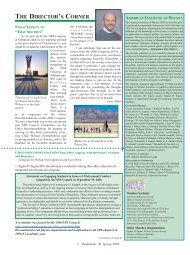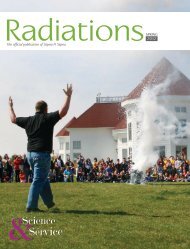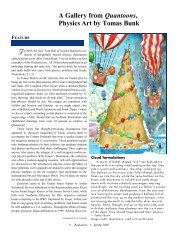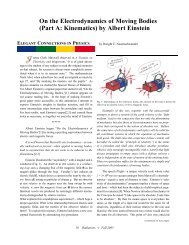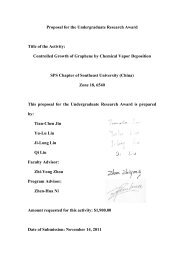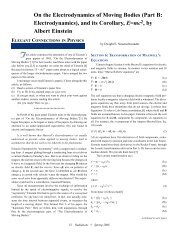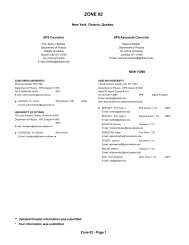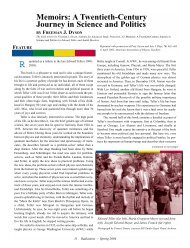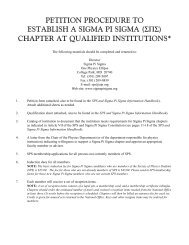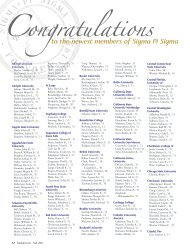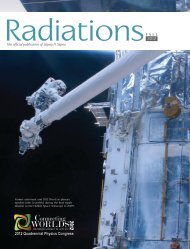History of Big Bang Cosmology, Part 4 - Sigma Pi Sigma
History of Big Bang Cosmology, Part 4 - Sigma Pi Sigma
History of Big Bang Cosmology, Part 4 - Sigma Pi Sigma
- No tags were found...
You also want an ePaper? Increase the reach of your titles
YUMPU automatically turns print PDFs into web optimized ePapers that Google loves.
Elegant Connections in Physics by Dwight E. Neuenschwander<br />
<strong>History</strong> <strong>of</strong> <strong>Big</strong> <strong>Bang</strong> <strong>Cosmology</strong>, <strong>Part</strong> 4:<br />
The Expanding Universe, Ylem, and the CMBR<br />
I. Introduction<br />
This article continues our brief history <strong>of</strong> big bang cosmology[1-3]<br />
with an overview <strong>of</strong> the predictions <strong>of</strong> the expansion <strong>of</strong><br />
the universe and the cosmic microwave background radiation.<br />
Albert Einstein started modern cosmology with his 1917 paper<br />
that applied general relativity (GR) to the entire universe.[4] To<br />
resolve the problem at infinity that long plagued Newtonian cosmology,<br />
Einstein abolished infinity by modeling the universe as a<br />
uniform distribution <strong>of</strong> stars in a spherical space closing back on<br />
itself (positive curvature). To obtain a static solution, he also had<br />
to introduce the cosmological constant > 0, which, in effect,<br />
canceled at the cosmic scale the gravitation <strong>of</strong> matter. That same<br />
year Wilhelm de Sitter found an alternative closed static solution<br />
that required the cosmological constant but contained no<br />
matter![5] For a light source at radial coordinate r relative to<br />
an observer at the origin, the “de Sitter effect” gave a fractional<br />
change in wavelength / ~ ar 2 (1 ar 2 ) 1 . This was<br />
not a Doppler effect, although it was <strong>of</strong>ten interpreted as one;<br />
rather, the meterstick to measure wavelength gets altered. de<br />
Sitter’s model had curvature and cosmic redshifts without matter;<br />
Einstein’s model had curvature and matter without cosmic<br />
redshifts. The real universe has matter and redshifts. Between<br />
1917 and about 1930, the argument was over which <strong>of</strong> these two<br />
models best fit the real universe. Even Edwin Hubble, who in<br />
1929 published the first installment <strong>of</strong> data that showed the universe<br />
to be expanding, first interpreted his results as evidence for<br />
de Sitter redshifts.[6,7]<br />
Tentative steps towards loosening the rigidities <strong>of</strong> a static universe<br />
were taken by Comes Lanzcos (1922), Georges Lemaître<br />
(1925), and H.P. Robertson (1928), who performed coordinate<br />
transformations on the de Sitter metric, shifting some timedependence<br />
into the coefficients <strong>of</strong> the spatial displacements.<br />
[8] But new dynamical thinking came from Russia, in the person<br />
<strong>of</strong> Alexander A. Friedmann. In 1922 and 1924 he published<br />
two revolutionary papers. The first showed how GR allowed a<br />
closed universe to have a time-dependent radius.[9] The 1924<br />
paper showed that Einstein’s equations also allowed an “open”<br />
hyperbolic (negative curvature) universe.[10] Unfortunately,<br />
Friedmann’s work went unnoticed at that time. Even more sadly,<br />
he never lived to see his ideas vindicated, as he passed away<br />
from typhoid in 1925.[11]<br />
In 1924 the young Abbé Georges Lemaître from Belgium<br />
was visiting MIT after studying physics at Cambridge under Sir<br />
Arthur Eddington. While in America Lemaitre attended a meeting<br />
<strong>of</strong> the National Academy <strong>of</strong> Sciences in Washington, DC.<br />
There he heard Hubble present his results on measuring the distance<br />
to the Andromeda galaxy. Lemaître returned to Belgium<br />
inspired and in 1927 independently rediscovered Friedmann’s<br />
dynamic universe.[12]<br />
At a meeting <strong>of</strong> the Royal Astronomical Society in 1930, “de<br />
Sitter propounded the dilemma that the actual universe apparently<br />
contained enough matter to make it an Einstein world and<br />
enough motion to make it a de Sitter world.”[13] About this<br />
Arthur Eddington insightfully reflected, “One puzzling question<br />
is why there should be only two solutions. I suppose the<br />
trouble is that people look for static solutions.”[14] Lemaître<br />
read these remarks and sent Eddington a copy <strong>of</strong> his 1927 paper<br />
on an expanding universe. Upon seeing it, Eddington wrote to<br />
de Sitter:<br />
“...it was the report <strong>of</strong> your remarks and mine at the [Royal<br />
Astronomical Society] which caused Lemaître to write me about<br />
it...A research student [G.C.] McVittie and I had been worrying<br />
at the problem and made considerable progress; so it was a blow<br />
to us to fi nd it done much more completely by Lemaître (a blow<br />
s<strong>of</strong>tened, as far as I am concerned, by the fact that Lemaître was<br />
a student <strong>of</strong> mine).”[15]<br />
In 1932 the Friedman-Lemaître metric was derived with<br />
enhanced rigor by H.P. Robertson and A.G. Walker. Today the<br />
“FLRW metric” forms the working tool <strong>of</strong> modern cosmological<br />
discussion.[16] Its implications for the expansion <strong>of</strong> the universe<br />
occupies Section II.<br />
When the evidence became convincing that the universe really<br />
is expanding, Lemaître was one <strong>of</strong> the first to take seriously the<br />
implication that, very early in cosmic history, all the mass-energy<br />
within the observable universe would have been compressed<br />
into a space rescaled to diminutive size. After the neutron was<br />
discovered by James Chadwick in 1932, a large piece <strong>of</strong> the<br />
nuclear puzzle fell into place, which released a brake on attempts<br />
to understand the origin <strong>of</strong> the elements. The synthesis <strong>of</strong> nuclei<br />
in stars began to be understood, but it was realized that some<br />
prestellar nucleosynthesis must have occurred.[17] Thereby<br />
was attention brought to the very early expanding universe as<br />
an environment <strong>of</strong> sufficiently high temperature and density<br />
to drive some prestellar synthesis. In Section III we consider<br />
the thoughts <strong>of</strong> those who first tried to understand this environment<br />
and its processes, among them S. Chandrasekhar, George<br />
Gamow, Ralph Alpher, and Robert Herman. Alpher and Herman<br />
predicted the existence and present temperature <strong>of</strong> the CMBR,<br />
the definitive signature <strong>of</strong> a universe that began with a “hot big<br />
bang.”<br />
II. An Expanding Universe<br />
In special relativity the time interval dt and the space interval<br />
ds between two events are not separately invariant among inertial<br />
Spring 2009 Radiations 19
eference frames, but the difference in their squares, the “spacetime<br />
interval,” is invariant and equals the square <strong>of</strong> the proper<br />
time d between the events, d 2 = dt 2 ds 2 (absorbing c into t<br />
to measure time in meters). GR allows transformations among<br />
accelerated frames. Thanks to the equivalence principle for gravitational<br />
and inertial mass, GR <strong>of</strong>fers a theory <strong>of</strong> gravity. In terms<br />
<strong>of</strong> four space-time coordinates x , the space-time interval between<br />
a pair <strong>of</strong> neighboring events may be written in general as<br />
d 2 = g <br />
dx dx (1)<br />
(sum over repeated indices), where the coefficients g <br />
denote<br />
components <strong>of</strong> the metric tensor (or matrix) that converts coordinate<br />
displacements into distances. Given a distribution <strong>of</strong> massenergy<br />
as the source <strong>of</strong> the gravitational field, Einstein’s field<br />
equations <strong>of</strong> GR are second-order partial differential equations<br />
that one solves for g <br />
. The mass-energy information is encoded<br />
into another matrix T <br />
, whose components include energy density<br />
and pressure terms. The cosmological constant serves as<br />
another gravitational source. The field equations take the schematic<br />
form<br />
[g(g) + 2 g terms] <br />
= 8GT <br />
+ g <br />
, (2)<br />
where G denotes Newton’s gravitational constant.<br />
Alexander Friedmann was attracted to the mathematical challenges<br />
<strong>of</strong> GR. His 1922 cosmology paper bears the modest title<br />
“On the curvature <strong>of</strong> space,” but the subject was dynamics.[9] Like<br />
Einstein and de Sitter, he considered universe filled with uniform<br />
densities <strong>of</strong> matter and radiation, in a closed, spherical geometry,<br />
with three-dimensional space conceputalized as the surface <strong>of</strong> a<br />
hypersphere <strong>of</strong> radius a embedded in a Euclidean space <strong>of</strong> four<br />
dimensions. But unlike his predecessors, Friedmann allowed a to<br />
vary with time. In 1923 he also applied Lobachevskian geometry,<br />
spaces <strong>of</strong> negative curvature, to GR. The resulting paper, called<br />
“On the possibility <strong>of</strong> a world with constant negative curvature,”<br />
was published in 1924.[10] Here one imagines three-dimensional<br />
space as a hyperbolic surface embedded in four-dimensional<br />
Euclidian space.<br />
The closed and open geometries may be parameterized, for<br />
homogeneous and isotropic space, as<br />
d 2 = dt 2 a 2 [(1 kr 2 ) 1 dr 2 r 2 (d 2 + sin 2 d 2 )], (3)<br />
where (r,,) denote familiar spherical coordinates. The parameter<br />
a = a(t) allows space to be rescaled as time t elapses; r has<br />
been normalized to a dimensionless coordinate-grid label; and k<br />
= +1 (1) for the closed (open) universe, with k = 0 for no-curvature<br />
“flat” geometry.<br />
With the mass-energy distribution <strong>of</strong> matter and radiation modeled<br />
as a smoothed-out energy density = mat<br />
+ rad<br />
and an<br />
equation <strong>of</strong> state relating pressure P to , the field equations <strong>of</strong><br />
GR may may be written as a pair equations for the evolution <strong>of</strong><br />
a(t):<br />
(da/dt) 2 = a 2 + aa 2 k (4)<br />
and<br />
d 2 a/dt 2 = ½( + 3P)a + aa, (5)<br />
where 8G/3.<br />
The study <strong>of</strong> a(t) now forms our task. If a(t) begins from zero,<br />
in that first instant it expands infinitely fast from a state <strong>of</strong> infinite<br />
energy density. Friedmann’s biographers observe, “The discovery<br />
<strong>of</strong> the initial singularity is one <strong>of</strong> the most remarkable achievements<br />
<strong>of</strong> Friedmann’s theory... ”[18] The subsequent expansion<br />
is described by well-behaved functions. At small values <strong>of</strong> a in<br />
the early expansion, 1/a dominates over other terms and the equations<br />
integrate to a power law, a(t) ~ t b . If the universe continues<br />
to expand, a(t) swells so large that the universe approaches a state<br />
<strong>of</strong> vanishing energy density and exponential growth, a(t) ~ e at .<br />
To examine the more nuanced behavior <strong>of</strong> a(t), transpose Eq.<br />
(4) into an expression for da/dt. For the closed universe,<br />
da/dt = (a) a [ Q(a)] ½ , (6)<br />
where<br />
Q(a) (3/a 3 )(a a 1<br />
) (7)<br />
and a 1<br />
a 3 , which is constant by conservation <strong>of</strong> energy. For<br />
Fig. 1. W(a) in the open universe model. As a increases from 0, W begins<br />
from a singularity, going asymptotically to 0 as a .<br />
Fig. 2. Graph <strong>of</strong> Q(a) showing its asymptotic behavior as a 0 and as a<br />
. A zero <strong>of</strong> Q occurs at a = a 1<br />
, its maximum at a = 3a 1<br />
/2, and an inflection<br />
point at a = 2a 1<br />
.<br />
20 Radiations Spring 2009
the open universe,<br />
da/dt = (a) a [ + W(a)] ½ (8)<br />
where<br />
W(a) (3/a 3 )(a + a 1<br />
) . (9)<br />
Sketches <strong>of</strong> W(a) and Q(a) appear in Figs. 1 and 2.<br />
In an open universe, W exhibits no maximum or minimum, and<br />
the open universe expands forever. However, a closed universe<br />
<strong>of</strong>fers other possibilities. For da/dt to be real, Eq. (6) demands <br />
Q(a), where Q max<br />
= 4/9a 12<br />
. Consider three cases:<br />
(a) > Q max<br />
. From Eq. (6) we find that da/dt remains a real<br />
number for all values <strong>of</strong> a. The universe expands monatonically<br />
while experiencing gravitational deceleration from a = 0 to a =<br />
2a 1<br />
. When a > 2a 1<br />
the expansion accelerates with positive sign as<br />
the cosmological constant dominates over energy density.<br />
(b) If = Q max<br />
precisely, then as a grows from zero it decelerates<br />
until reaching a = 3a 1<br />
/2, where the expansion halts. The<br />
static Einstein universe, contained in the Friedmann model as a<br />
special case, may now be recognized as unstable, poised between<br />
collapse and runaway expansion on a precarious peak at a =<br />
3a 1<br />
/2.<br />
(c) If 0 < Q max<br />
, a turning point occurs when Q(a) = ,<br />
which puts a turning point a T<br />
in the range a 1<br />
a T<br />
< 3a 1<br />
/2.<br />
Because d 2 Q/da 2 < 0 in this region, upon hitting the turning point<br />
the expansion halts and the universe begins to contract, ultimately<br />
into another singularity. The simplest such case occurs when <br />
= 0. Defining d dt/a(t), a parametric solution <strong>of</strong> a cycloid<br />
results:[19]<br />
a = ½a o<br />
(1 cos ), t = ½a o<br />
( sin ), (10)<br />
at fixed coordinates. Even when A and B do not move through<br />
space they are carried apart, at a rate proportional to their separation,<br />
by the stretching <strong>of</strong> space. The FLRW model predicts a<br />
velocity-distance relation. From the space time interval, the distance<br />
s between events 1 and 2 at fixed coordinates r 1<br />
and r 2<br />
on a<br />
radial line is<br />
r 2<br />
s = a(t) (1 kr 2 ) ½ dr, (11)<br />
r 1<br />
which increases at the rate v ds/dt = (da/dt) s/a. If we define<br />
the parameter<br />
H(t) (1/a) (da/dt) = [(8G/3) k/a 2 + a] ½ , (12)<br />
then we have the “velocity-distance relation,”<br />
v = Hs. (13)<br />
When current values <strong>of</strong> the parameters are used, Eq. (13) is called<br />
“Hubble’s Law.” The velocity-distance relation means that space<br />
itself gets rescaled. (Galaxies and people do not expand, because<br />
they are held together by their internal forces.)<br />
III. Ylem and the CMBR<br />
When the data on the velocity-distance relation became robust<br />
enough to convince everyone that the universe really expands,<br />
Lemaître took seriously the inferences. Thereby did cosmology<br />
take the next step beyond dynamic geometry, to early-universe<br />
thermodynamics and nuclear physics. Since the universe expands<br />
now, it must have existed at smaller scales in the past. When<br />
a(t) was very small, the universe would have been astonishingly<br />
dense. Since the largest density known to exist was nuclear matter,<br />
Lemaître suggested the state <strong>of</strong> matter in the early universe<br />
Fig. 3. The expansion and re-contraction <strong>of</strong> the closed, perhaps oscillating,<br />
universe.<br />
describing the trajectory <strong>of</strong> Fig. 3, with period T = a 1<br />
for the<br />
entire cycle. Perhaps the cycle repeats from infinite past and into<br />
an infinite future (but that raises difficulties with Second Law <strong>of</strong><br />
Thermodynamics).<br />
The expansion carries apart any two points A and B located<br />
Fig. 4. Schematic smoothed-out plot <strong>of</strong> the logarithm <strong>of</strong> relative abundance<br />
vs. mass number A = number <strong>of</strong> protons plus neutrons. The curve<br />
is approximately exponential out to about A 100 and constant thereafter.<br />
may have been a giant nucleus, a “primaeval atom” or “cosmic<br />
egg.” As the expansion began, the cosmic forces were local,<br />
stretching the primordial nucleus apart, eventually onto “our poor<br />
little atoms.”[20] Lemaître sought in this scenario an explanation<br />
for high-energy cosmic rays.<br />
Spring 2009 Radiations 21
By the 1930s the relative abundances <strong>of</strong> the various nuclear<br />
species and their isotopes were known (see Fig. 4), and that distribution<br />
was apparently universal across the observable cosmos.<br />
It was also known that these abundances could not be accounted<br />
for entirely by nuclear reactions in stars,[17] suggesting a prestellar<br />
episode <strong>of</strong> element production in cosmic history. This discussion<br />
requires a small digression into early-universe thermodynamics.<br />
Let’s do some back-<strong>of</strong>-the-envelope calculations here.<br />
By differentiating Eq. (4) with respect to time and neglecting <br />
(which is small anyway, and negligible in the early universe) and<br />
using Eq. (5) we derive<br />
d(a 3 ) = 3Pa 2 da. (14)<br />
Because denotes energy density and because the volume V <strong>of</strong><br />
the universe is proportional to a 3 , the term a 3 represents the<br />
“internal energy” U <strong>of</strong> the universe. Thus Eq. (14) may be written<br />
dU = P dV, which resembles the combined 1st and 2nd laws<br />
<strong>of</strong> thermodynamics, dU = TdS PdV, but without the entropy S.<br />
So in the early universe, entropy is conserved, dS/dt = 0. One<br />
may calculate S from its usual definition:<br />
S = (dU + PdV) / T ~ ( + P) a 3 / T, (15)<br />
where we take the state variables to be spatially uniform, in keeping<br />
with the assumption <strong>of</strong> homogeneity and isotropy. Equation<br />
(15) enables us to relate a to the temperature. In the very early<br />
universe, all the particles move at practically the speed <strong>of</strong> light.<br />
Therefore, like the photon, their energy densities and pressures<br />
are proportional to T 4 (Stefan’s law). Then from Eq. (15), it<br />
follows that S ~ T 3 a 3 , but S = const., so the universe expands<br />
and cools adiabatically according to T = b/a, where b is some<br />
constant. To eliminate b we find the temperature T as a function<br />
<strong>of</strong> time t. From Stefan’s law we have P ~ = T 4 = b 4 /a 4 (<br />
denotes the Stefan’s law constant, weighted by spin multiplicities).<br />
When placed into Eq. (4) without , this yields<br />
(da/dt) 2 + k = (/a) 2 (16)<br />
where 2 = b 4 . At early times when a is small the 1/a 2 term<br />
dominates over k, so that da/dt /a, with solution a 2 = 2t.<br />
Since a = b/T, the b cancels, and we find<br />
T 2 t 1.910 20 K 2 s. (17)<br />
(The 1.9 coefficient is faithful to my little calculation here; other<br />
authors always get something near 2).[21]<br />
If one imagines the prestellar universe to be a gas <strong>of</strong> neutrons<br />
and protons (transforming into one another by beta decay and<br />
its inverse), with an increasing contamination <strong>of</strong> nuclei made<br />
by their collisions, and if during those high-temperature collisions<br />
the nuclear species are in “chemical” equilibrium with<br />
one another, then when the temperature drops to the point where<br />
fusion no longer occurs, those reactions cease and the abundance<br />
ratios <strong>of</strong> that moment would be “frozen” in. This idea was developed<br />
with great thoroughness by S. Chandrasekhar and Louis R.<br />
Henrich in 1942.[22] They carried out a complex problem whose<br />
strategy may be illustrated with a toy model. Consider elements<br />
X, Y, and Z that can change into one another as follows:<br />
k h<br />
X Y Z .<br />
k’ h’<br />
The rate at which the concentration [X] <strong>of</strong> species X decays to Y<br />
is proportional to the concentration <strong>of</strong> [X], with some coefficient<br />
k, and the rate at which X gets made from Y depends on the concentration<br />
[Y], with some coefficient k’. Therefore we may write<br />
d[X]/dt = k[X] + k’ [Y]. (18)<br />
Including the other transformations between Y and Z with rate<br />
coefficients h and h’, we write<br />
d[Y]/dt = (k’ + h)[Y] +k [X] + h’ [Z] (19)<br />
d[Z]/dt = h’ [Z] + h [Y]. (20)<br />
In equilibrium, d[X]/dt = d[Y]/dt = d[Z]/dt = 0, and we find [Y]/<br />
[X] = k/k’ and [Z]/[X] = kh/k’h’. If the coefficients are known<br />
functions <strong>of</strong> temperature, and the temperature a known function<br />
<strong>of</strong> time, and if the present abundances are the “frozen in” values<br />
they had when the reactions were suddenly quenched, then from<br />
the observed abundances we can find the time and temperature<br />
<strong>of</strong> that quenching. Invariably the Boltzmann factor makes an<br />
appearance, so that [Y]/[X] or [Z]/[X] ~ exp(mc 2 /k B<br />
T), where<br />
m is the mass defect (or binding energy) and k B<br />
Boltzmann’s<br />
constant. If the time and temperature <strong>of</strong> the quenching can be<br />
found by fitting to a known abundance, the rest can be predicted.<br />
This program agreed well with the exponential decline for about<br />
the first half <strong>of</strong> the periodic table, but for the second half, where<br />
the actual abundance levels <strong>of</strong>f, the predictions continue their<br />
exponential decline. By 1946 George Gamow was suggesting in<br />
a series <strong>of</strong> talks and papers that “it appears that the only way <strong>of</strong><br />
explaining the observed abundance-curve lies in the assumption<br />
<strong>of</strong> some kind <strong>of</strong> unequilibrium process taking place during a limited<br />
interval <strong>of</strong> time.”[23]<br />
Gamow had tremendous intuition and physical insight, but<br />
mathematical patience for complex calculations was not his primary<br />
strength. Therefore when his graduate student Ralph A.<br />
Alpher was in need <strong>of</strong> a second PhD dissertation topic,[24] he<br />
took on the task <strong>of</strong> predicting the abundances <strong>of</strong> the elements in<br />
the complicated, out-<strong>of</strong>-equilibrium dynamics <strong>of</strong> the high-temperature<br />
environment in the early universe.<br />
This good work resulted in a series <strong>of</strong> papers by Alpher and<br />
his colleagues over the next several years. The first to emerge<br />
from the dissertation was published in Physical Review in April<br />
1948, bearing the title “The Origin <strong>of</strong> Chemical Elements.”[25]<br />
Gamow, an irredeemable prankster, could not resist the temptation<br />
to put the name <strong>of</strong> Hans Bethe on the paper, called to this day<br />
the “ paper.”<br />
Our Greek-letter authors wrote, “According to this picture, we<br />
must imagine the early state <strong>of</strong> matter as a highly compressed<br />
neutron gas (overheated nuclear fluid) which started decaying<br />
into protons and electrons when the gas pressure fell down as<br />
22 Radiations Spring 2009
the result <strong>of</strong> universal expansion. The radiative capture <strong>of</strong> the<br />
still-remaining neutrons by the newly formed protons must have<br />
led first to the formation <strong>of</strong> deuterium nuclei, and the subsequent<br />
neutron captures resulted in the building up <strong>of</strong> heavier and<br />
heavier nuclei.” For nuclear species i = 1,2,3,....,238 denoting all<br />
the nuclei with mass number i = A out to uranium (the various<br />
isotopes for common A emerging later from beta decays), the rate<br />
equations for this building-up process (neglecting fissions) are <strong>of</strong><br />
the form<br />
dn i<br />
/dt = f (t) [ i1<br />
n i 1<br />
i<br />
n i<br />
], (21)<br />
where f (t) carries the time-dependent factors, n i<br />
denotes the<br />
particle density <strong>of</strong> species i, and i<br />
denotes its cross-section for<br />
neutron absorption (recall the cross-section is the area, centered<br />
on the target nucleus, within which the neutron must hit to make<br />
the reaction go). Given the rapidity <strong>of</strong> the reactions compared to<br />
the neutron half-life, assumed the nuclear reactions went to<br />
completion in a time short enough that the expansion was negligible<br />
during those moments. Upon integrating the coupled rate<br />
equations, our authors found that the curve <strong>of</strong> relative abundances<br />
could be fit, for essentially all the elements, with a common value<br />
<strong>of</strong> n<br />
t = 510 4 g s/cm 3 , the product <strong>of</strong> neutron density and time<br />
interval during which the element buildup occurred. Alpher’s<br />
calculations showed the process <strong>of</strong> element-building by neutron<br />
capture to be essentially finished when t 5 min.<br />
These calculations were explained in more detail in a longer<br />
paper written by Alpher alone later that year, “A Neutron-<br />
Capture Theory <strong>of</strong> the Formation and Relative Abundance <strong>of</strong> the<br />
Elements.”[26] Into this discussion Alpher introduced the antique<br />
word ylem, pronounced §’-lm, the primordial stuff from which<br />
Fig. 5. Robert Herman (L) and Ralph Alpher (R) witness George Gamow<br />
emerge from a bottle <strong>of</strong> ylem. This slide was sneaked into a stack for a<br />
talk that Gamow presented. He saw it first when it flashed boldly on the<br />
screen. Alpher noted the bottle’s “contents were partially consumed by<br />
those in the photo to celebrate the mailing <strong>of</strong> the Alpher-Bethe-Gamow<br />
paper to Physical Review in 1948.” Photo courtesy <strong>of</strong> Victor Alpher.<br />
all matter condensed (see Fig. 5). Alpher noted, “According<br />
to Webster’s New International Dictionary, 2nd ed., the word<br />
‘ylem’ is an obsolete noun meaning ‘The primordial substance<br />
from which the elements were formed.’ It seems highly desirable<br />
that a word <strong>of</strong> so appropriate a meaning be resurrected.” Yes,<br />
it should—and perhaps it has. My American Heritage College<br />
Dictionary defines ylem as “A form <strong>of</strong> matter hypothesized by<br />
proponents <strong>of</strong> the big bang theory to have existed before the formation<br />
<strong>of</strong> the chemical elements.” In Alpher’s models <strong>of</strong> 1948,<br />
the ylem was a liqueur <strong>of</strong> very hot neutrons that became enriched<br />
with protons, electrons, neutrinos, and heavier elements during<br />
the first five minutes <strong>of</strong> the expansion.<br />
Further refinements formed the subject <strong>of</strong> another 1948 paper,<br />
written by Alpher and his colleague from the Johns Hopkins<br />
Applied Physics Lab, Robert Herman, who had studied relativity<br />
at Princeton under H.P. Robertson. (It should be noted that<br />
Alpher and Herman did cosmology after their day jobs <strong>of</strong> mostly<br />
classified defense-related work on topics like the hydrodynamics<br />
<strong>of</strong> missile re-entry into Earth’s atmosphere.) Their first joint<br />
paper, “On the Relative Abundance <strong>of</strong> the Elements,” included<br />
the effects <strong>of</strong> the expansion during nucleosynthesis, and the<br />
beta decays.[27] It was one <strong>of</strong> their first co-published results in<br />
what would prove to be a half-century collaboration and lifetime<br />
friendship.[28]<br />
In the summer <strong>of</strong> 1948 while he was at Los Alamos, George<br />
Gamow wrote a hasty paper called “The Evolution <strong>of</strong> the<br />
Universe” that attempted to connect nucleosynthesis criteria<br />
to the formation <strong>of</strong> galaxies by gravitational condensation.[29]<br />
He mailed the paper to Nature and sent a copy to Alpher and<br />
Herman. They scrutinized his work, noticed some minor errors,<br />
and informed him <strong>of</strong> them. Gamow replied that it was too late<br />
to change his paper, which was already in Nature’s publication<br />
pipeline, but he asked the journal editors to watch for Alpher and<br />
Herman’s forthcoming corrections and publish them as soon as<br />
possible.<br />
Gamow’s paper appeared in the October 30 issue and the<br />
Alpher- Herman corrections appeared on November 13, the latter<br />
in a short but significant article also called “Evolution <strong>of</strong> the<br />
Universe.” At issue in Gamow’s paper, and corrected by Alpher<br />
and Herman, was the “cross-over time,” when the energy densities<br />
<strong>of</strong> matter and radiation became equal, a necessary condition<br />
for galaxies to form. After noting these corrections, Alpher and<br />
Herman remarked that, according to their thermodynamic calculations,<br />
“The temperature <strong>of</strong> the gas at the time <strong>of</strong> condensation was<br />
600K, and the temperature <strong>of</strong> the universe at the present time is<br />
found to be about 5K. We hope to publish the details <strong>of</strong> these<br />
calculations in the near future.”[30]<br />
Those details appeared in the Physical Review the following<br />
April as another article by Alpher and Herman, called “Remarks<br />
on the Evolution <strong>of</strong> the Expanding Universe.”[31] Our authors<br />
considered “an expanding universe <strong>of</strong> non-interconverting matter<br />
and radiation,” after matter-radiation decoupling when their<br />
energy densities became separately conserved. The conservation<br />
<strong>of</strong> matter gives m<br />
a 3 = const. If the radiation energy density is<br />
given by a Planck blackbody spectrum, r<br />
~ T 4 , and an adiabatic<br />
expansion where T ~ 1/a, one has r<br />
a 4 = const. Putting these<br />
together, it follows that<br />
Spring 2009 Radiations 23
m<br />
r<br />
4/3<br />
= const. (21)<br />
Using primes to denote “then” as the time <strong>of</strong> element formation<br />
in the early universe, and double primes to denote “now,” Alpher<br />
״ and Herman calculated that “the specification <strong>of</strong> m<br />
׳ , m<br />
׳ , and r<br />
״r fixes the present density <strong>of</strong> radiation, <br />
. In fact, we find that the<br />
״ value <strong>of</strong> r<br />
, consistent with Eq. (4) [our Eq. (21)], is<br />
״ r<br />
10 32 g/cm 3 ,<br />
which corresponds to a temperature now <strong>of</strong> the order <strong>of</strong> 5K.<br />
This mean temperature for the universe is to be interpreted as the<br />
background temperature which would result from the universal<br />
expansion alone.”<br />
Radiation at a temperature <strong>of</strong> a few Kelvins means that the cosmic<br />
afterglow <strong>of</strong> the big bang would exhibit a Planck spectrum<br />
peaked in the microwave part <strong>of</strong> the spectrum. Thus was the<br />
existence and temperature <strong>of</strong> the cosmic microwave background<br />
radiation (CMBR) predicted by Alpher and Herman in 1948 and<br />
1949.<br />
Throughout the balance <strong>of</strong> the 1940s and through the 1950s,<br />
they attempted to convince radio astronomers to search for<br />
this relic radiation, to no avail. However, it seems to have<br />
been detected (but not recognized as the CMBR) in the early<br />
1940s,[32] and discovered (and recognized) in the USSR in 1957.<br />
[33] Few noticed.<br />
In late 1964, A. Penzias and R. Wilson serendipitously<br />
detected an unaccounted-for 3 K temperature excess in their<br />
microwave antenna.[34] The Princeton group <strong>of</strong> R.H. Dicke,<br />
P.J.E. Peeble, P.G. Roll, and D.T. Wilkinson interpreted the discovery<br />
as a CMBR.[35] Neither one <strong>of</strong> these papers cited the<br />
CMBR prediction <strong>of</strong> Alpher and Herman, and until recent years<br />
few seemed to recall the Alpher-Herman prediction <strong>of</strong> the CMBR<br />
at all. Over the years, the error <strong>of</strong> citing Gamow or “Gamow and<br />
his students” as the original author <strong>of</strong> the CMBR prediction has<br />
been propagated.<br />
This unfortunate circumstance put Ralph Alpher and Robert<br />
Herman in the distinguished cosmological company <strong>of</strong> Alexander<br />
Friedmann and Georges Lemaître. As in their cases, the overdue<br />
record <strong>of</strong> priority is slowly being set straight.[36-39] The detection<br />
<strong>of</strong> the CMBR, whose existence was predicted by Alpher and<br />
Herman, was the cinching link between theory and evidence that<br />
compelled the astrophysics community to take the hot big bang<br />
seriously. Friedmann and Lemaítre “made the universe expand,”<br />
and Alpher and Hermann made it glow.<br />
Acknowledgments<br />
I express my deep thanks and appreciation to Victor Alpher.<br />
With gratitude I also thank Charles Misner for his generous<br />
advice given at the beginning <strong>of</strong> this multiarticle project.<br />
[1] “A Survey <strong>of</strong> <strong>Big</strong> <strong>Bang</strong> <strong>Cosmology</strong>, <strong>Part</strong> 1: Cosmic<br />
Geography,” Radiations 13, 14-18 (Fall 2007).<br />
[2] “<strong>History</strong> <strong>of</strong> <strong>Big</strong> <strong>Bang</strong> <strong>Cosmology</strong>, <strong>Part</strong> 2: The Problem with<br />
Infinity,” Radiations 14, 25-29 (Spring 2008).<br />
[3] “<strong>History</strong> <strong>of</strong> <strong>Big</strong> <strong>Bang</strong> <strong>Cosmology</strong>, <strong>Part</strong> 3: The de Sitter<br />
Universe and Redshifts,” Radiations 14, 23-27 (Fall 2008).<br />
[4] A. Einstein, 1917 “Cosmological Considerations on the<br />
General Theory <strong>of</strong> Relativity, tr. in The Principle <strong>of</strong> Relativity<br />
(Dover, 1952), pp. 177-188.<br />
[5] W. de Sitter, Proc. Roy. Acad. Sci. (Amsterdam) 19, 1217<br />
(1917); 20, 229 (1917); 20, 1309 (1917); Mon. Not. Roy. Astron.<br />
Soc. 78, 3 (1917).<br />
[6] E. Hubble, “A Relation between Distance and Radial Velocity<br />
among Extra-Galactic Nebulae,” Proc. Natl. Acad. <strong>of</strong> Sci. U.S.A.<br />
15, 168-173 (1929).<br />
[7] G.F.R. Ellis, “Innovation, Resistance and Change: The<br />
Transition to the Expanding Universe,” in Modern <strong>Cosmology</strong> in<br />
Retrospect, B. Bertotti, R. Balbinot, S. Bergia, and A. Messina,<br />
Eds., (Cambridge Univ. Pr. 1990), p. 104.<br />
[8] J.D. North, The Measure <strong>of</strong> the Universe: A <strong>History</strong> <strong>of</strong><br />
Modern <strong>Cosmology</strong> (Oxford, 1965, Dover 1990), p. 111-112.<br />
[9] A. Friedmann, “On the Curvature <strong>of</strong> Space,” Zeitschrift für<br />
Physik 10, 379 (1922).<br />
[10] A. Friedmann, “On the Possibility <strong>of</strong> a World with Constant<br />
Negative Curvature,” Zeitschrift für Physik 21, 326 (1924).<br />
[11] E.A. Tropp, V.Ya. Frenkel, and A.D. Chernin, Alexander<br />
A. Friedmann: The Man who Made the Universe Expand<br />
(Cambridge Univ. Pr., 1993).<br />
[12] A.G. Lemaître, Ann. Soc. Sci. Brux. A47, 49 (1927); “A<br />
Homogeneous Universe <strong>of</strong> Constant Mass and Increasing Radius<br />
accounting for the Radial Velocity <strong>of</strong> Extra-galactic Nebulae,”<br />
Proc. Roy. Ast. Soc. XCI 5, 483-501 (1931).<br />
[13] Ellis, ref. 7, p. 105, which gives the original references to<br />
the 1930 meeting proceedings.<br />
[14] ibid.<br />
[15] Quoted in P.J.E. Peebles, Principles <strong>of</strong> Physical <strong>Cosmology</strong><br />
(Princeton Univer. Pr., 1993), p. 80.<br />
[16] C. Misner, K. Thorne, and J. Wheeler, Gravitation (Freeman,<br />
1972), Ch. 27<br />
[17] E.g., G. Gamow and E. Teller, “Energy Production in Red<br />
Giants,” Phys. Rev. 55, 791 (1955).<br />
[18] Tropp, Frenkel, Chernin, ref. 11, p. 158.<br />
[19] E.g., Misner, Thorne, Wheeler, ref. 16, pp. 704-710.<br />
[20] Quoted in G. Gamow, The Creation <strong>of</strong> the Universe<br />
(Viking, 1961), p. 53.<br />
[21] B. Eskridge and D.E. Neuenschwander, “A Pedagogical<br />
Model <strong>of</strong> Primordial Helium Synthesis,” Am. J. Phys. 64, 1517-<br />
1524 (1996).<br />
[22] S. Chandrasekhar and L.R. Henrich, “An Attempt to Interpret<br />
the Relative Abundances <strong>of</strong> the Elements and Their Isotopes,”<br />
Ast. J. 9, 288-298 (1942).<br />
[23] G. Gamow, “Concerning the Origin <strong>of</strong> Chemical Elements,”<br />
J. Wash. Acad. Sci. 32, 353-373 (1942); “Expanding Universe and<br />
the Origin <strong>of</strong> Elements,” Phys. Rev. 70, 572-573 (1946).<br />
[24] Alpher had almost completed a dissertation on galaxy formation<br />
when he was “scooped” by E. Lifchitz. See the biographical<br />
article by Victor Alpher that begins on p. 15 <strong>of</strong> this issue <strong>of</strong><br />
Radiations.<br />
[25] R.A. Alpher, H. Bethe, and G. Gamow, “The Origin <strong>of</strong><br />
Chemical Elements,” Phys. Rev. 73, 803-804 (1948).<br />
[26] R. Alpher, “A Neutron-Capture Theory <strong>of</strong> the Formation and<br />
Relative Abundance <strong>of</strong> the Elements,” Phys. Rev. 74, 1577-1589<br />
(1948).<br />
24 Radiations Spring 2009
[27] R. Alpher and R. Herman, “On the Relative Abundance <strong>of</strong><br />
the Elements,” Phys. Rev. 74, 1737-1742 (1948).<br />
[28] Their papers from this era on these subjects, authored separately<br />
or jointly by Alpher, Gamow, Herman, and Follin, are not<br />
listed in their entirety here. We plead lack <strong>of</strong> space.<br />
[29] G. Gamow, “The Evolution <strong>of</strong> the Universe,” Nature 162,<br />
680-682 (1948).<br />
[30] R. Alpher and R. Herman, “Evolution <strong>of</strong> the Universe,”<br />
Nature 162, 774-775 (1948).<br />
[31] R. Alpher and R. Herman, “Remarks on the Evolution <strong>of</strong> the<br />
Expanding Universe,” Phys. Rev. 75, 1089-1095 (1949).<br />
[32] W.S. Adams, “Some Results with the Coudé Spectrograph<br />
<strong>of</strong> the Mount Wilson Observatory,” Ast. J., 93, 11-23 (1941). A.<br />
McKellar, “Evidence for the Molecular Origin <strong>of</strong> Some Hitherto<br />
Unidentified Interstellar Lines,” Pub. Ast. Soc. Pacifi c, 52, 307,<br />
187-192 1940; 53 233-235 (1941).<br />
[33] I.D. Novikov, Black Holes and the Universe, V. Kisin, Tr.<br />
(Cambridge Univ. Pr., 1984).<br />
[34] A. Penzias and R. Wilson, “A Measurement <strong>of</strong> Excess<br />
Antenna Temperature at 4080 Mc/s,” Astrophys. J. 142, 419-421<br />
(1965).<br />
[35] R.H. Dicke, P.J.E. Peebles, P.G. Roll, and D.T. Wilkinson,<br />
“Cosmic Black-Body Radiation,” Astrophys. J. 142, 414-419<br />
(1965).<br />
[36] M.S. Turner, “From to Precision <strong>Cosmology</strong>: The<br />
Amazing Legacy <strong>of</strong> a Wrong Paper,” Physics Today, 61, Dec<br />
2008. The was “wrong” for all the right reasons.<br />
[37] “April 1, 1948: The alpha beta gamma paper explains the<br />
origin <strong>of</strong> the elements,” APS News, April 2008, p. 2.<br />
[38] R. Alpher and R. Herman, “Reflections <strong>of</strong> Early Work on<br />
‘<strong>Big</strong> <strong>Bang</strong>’ <strong>Cosmology</strong>,” Physics Today 41, 24-34 (Aug 1988).<br />
[39] R. Alpher and R. Herman, Genesis <strong>of</strong> the <strong>Big</strong> <strong>Bang</strong> (Oxford<br />
Univ. Pr., 2001).<br />
Student Congress Perspectives continued from page 7<br />
Bringing it Home<br />
By the Kansas University SPS chapter<br />
[W]e used our next SPS meeting to have a roundtable<br />
discussion following up on topics from the conference.<br />
We shared with each other and with those unable<br />
to attend the Congress the interesting things we had<br />
heard and seen on our tours. We also discussed some <strong>of</strong><br />
the issues that the conference addressed, and what initiatives<br />
we felt we could practically pursue as a campus<br />
chapter. Among other things, we are hoping to establish<br />
a connection with students interested in science at the<br />
Native American university in our town and open a<br />
dialogue there.<br />
Seeing the Possibilities<br />
By the Abilene Christian University SPS chapter<br />
Overall the conference broadened our horizons on<br />
what is truly possible in the field <strong>of</strong> physics.<br />
The conference allowed all <strong>of</strong> us to look outside<br />
<strong>of</strong> our own personal experience as physicists, be it as<br />
students, researchers, or teachers, and view things from<br />
a more national and global perspective. It brought about<br />
reflection on what it means to live not just as a scientist,<br />
but as a citizen scientist, and imbued a sense <strong>of</strong> greater<br />
responsibility to the community that invests in us.<br />
The Congress brought together students, faculty,<br />
and alumni from over 170 campuses and institutions<br />
across the country. Our hope is that they continue<br />
the discussion <strong>of</strong> scientific citizenship back home<br />
with their colleagues and friends, and in this way<br />
move the physics community forward.<br />
Photo by Matt Noll.<br />
A view through Tractricious, a sculpture on the<br />
Fermilab grounds designed by founding director<br />
Robert R. Wilson. The free-standing hyperboloid is<br />
made from unused stainless steel beam pipe.<br />
Photo by Reidar Hahn, courtesy <strong>of</strong> Fermilab.<br />
Spring 2009 Radiations 25



